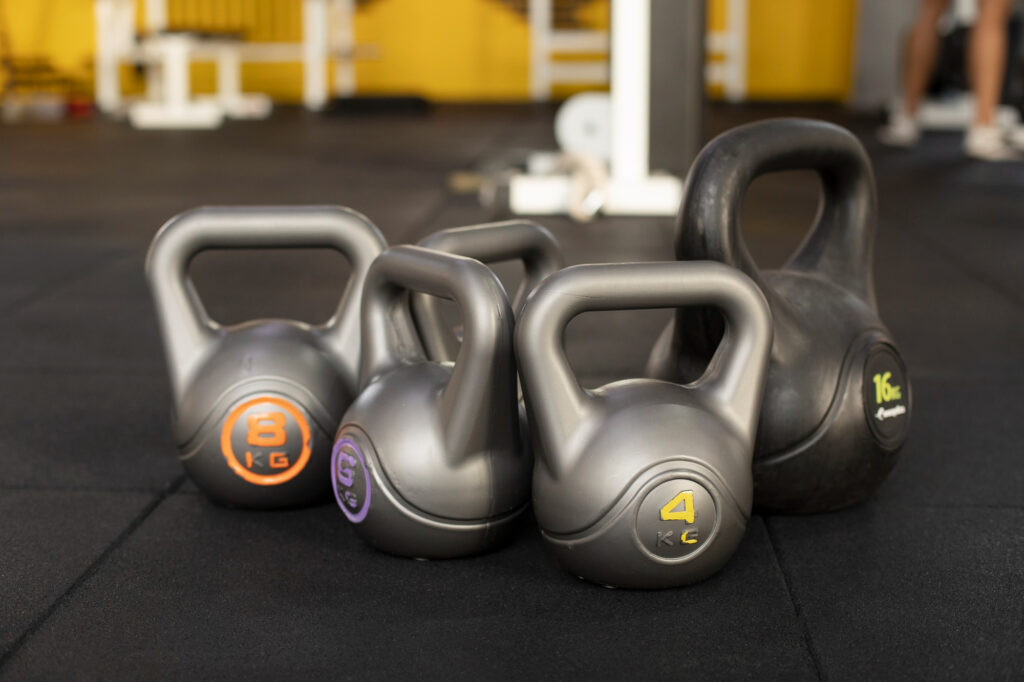Introduction
A kettlebell, crafted from robust cast-iron or cast-steel material, presents itself as a spherical weight adorned with a convenient handle affixed to its summit. This versatile fitness tool serves as the cornerstone for an array of physical activities, encompassing not only ballistic exercises but also an amalgamation of cardiovascular conditioning, muscular fortification, and the enhancement of suppleness. Its design, characterized by a seamless fusion of form and function, facilitates a holistic approach to fitness, promoting the harmonious development of various bodily faculties through dynamic movements and targeted exertion. Whether one seeks to elevate heart rate, sculpt muscles, or improve joint mobility, the kettlebell stands as a steadfast companion in the pursuit of comprehensive physical well-being.
The Evolution of Kettlebell: Tracing Their Historical Journey
The genesis of kettlebells can be traced back to the annals of ancient Russia, a civilization that venerated physical prowess and resilience. It was amidst this backdrop of reverence for strength that the term “girya” emerged, etching its inaugural mention into historical records within the pages of a 1704 Russian lexicon. During this epoch, kettlebells transcended their mundane role as mere counterweights in the bustling markets of rustic hamlets, evolving into instruments of physical expression and demonstration. Astute Russian laborers toiling in the fields unearthed the latent potential of the girya, harnessing its weight to execute fluid swings and commanding presses, thus showcasing their robust vigor and indomitable spirit.
As word of these remarkable displays spread, communities across villages and towns embraced kettlebell competitions as a cherished pastime, weaving them seamlessly into the fabric of local festivities, fairs, and even circuses, where feats of strength served as captivating spectacles that enthralled audiences and celebrated the enduring legacy of Russian athleticism.
Top-selling kettlebells available on Amazon:
Amazon Basics Cast Iron Kettlebells with Enamel Finish

Product Description:
- Dive into the world of versatile resistance training with our premium kettlebell offering.
- Crafted from durable, solid cast iron, this 35-pound kettlebell is engineered to withstand the rigors of your toughest workouts, ensuring longevity and reliability for years to come.
- Its sleek black enamel finish not only adds a touch of sophistication but also provides enhanced protection against corrosion, making it ideal for both indoor and outdoor use.
- The textured, wide handle is meticulously designed to offer a comfortable and secure grip, accommodating both single-handed and two-handed exercises with ease.
- Whether you’re swinging, squatting, or pressing, this kettlebell is your go-to companion for achieving your fitness goals.
- With dimensions measuring 8.4 x 5.3 x 9.4 inches (LxWxH), it strikes the perfect balance between compactness and functionality, fitting seamlessly into your home gym or workout space.
- Elevate your training regimen with our premium kettlebell and experience the difference in your strength and endurance.
Kettlebell Kings Powder-Coated Kettlebells

Product Description:
- Crafted from premium solid cast iron weighing 10 pounds, this kettlebell is a testament to durability and longevity, boasting a seamless construction without welds or weak points.
- Versatile for both indoor and outdoor workouts, it’s designed to withstand rigorous training sessions.
- The sleek black paint finish not only enhances its resistance to corrosion but also ensures a reliable grip, preventing slippage even during the most intense routines.
- Featuring a wide, smooth handle with a subtle texture, it offers a secure grip for repetitive motions, eliminating the need for chalk for both men and women alike.
- Additionally, its flat bottom guarantees stability, enabling convenient upright storage and facilitating various exercises such as renegade rows and handstands.
- Embodying versatility, this kettlebell serves as a multifunctional fitness tool, suitable for swings, deadlifts, squats, and more.
- Effectively targeting multiple muscle groups, including the biceps, shoulders, and legs, thus promoting overall strength and endurance.
Adjustable Kettlebell PowerBlock

Product Description:
- Introducing the PowerBlock kettlebell set, a revolutionary adjustable-weight solution that combines the solid feel of iron with customizable versatility.
- Ranging from 35 to 62 pounds, this kettlebell ensures easy weight selection, optimizing your workout experience.
- Its compact design makes it the ultimate choice for ergonomic and space-efficient strength training, with a contoured shell providing unmatched comfort throughout your routine.
- Ideal for both home and commercial gyms, these adjustable weights offer a cost-effective and space-saving alternative to traditional kettlebells.
- Thanks to the secure magnetic steel selection pin, adjusting the weight is a breeze, with increments at 35, 44, 53, and 62 pounds.
- Crafted for longevity, these kettlebell weights feature a high-quality all-steel construction, built to withstand years of use without compromise.
- With the ability to replace four kettlebells in the space of one, this set comes with the assurance of a 5-year warranty, guaranteeing peace of mind and unrivaled durability.
What are some popular kettlebell exercises?

Kettlebell Swing
A dynamic exercise where you swing the kettlebells between your legs and up to shoulder height using a hip-hinging motion, engaging the posterior chain muscles.
Kettlebell Clean
Lifting the kettlebells from the floor to the racked position at shoulder height in one smooth motion, emphasizing explosive hip drive.
Kettlebell Press
Pressing the kettlebells overhead from the racked position, focusing on shoulder and triceps strength and stability.
Kettlebell Push Press
Similar to the press, but with the addition of a knee dip to generate momentum, allowing for heavier weights to be lifted overhead.
Renegade Row
A challenging exercise performed in a plank position with hands on kettlebells, alternating rows are performed, engaging the core and back muscles.
Kettlebell Deadlift
Performing a traditional deadlift using a kettlebell, targeting the posterior chain muscles, particularly the hamstrings and glutes.
Kettlebell Snatch
Swiftly lifting the kettlebell from the ground to overhead in one powerful motion, combining elements of the swing and overhead press.
Kettlebell Jerk
Using a dip and drive motion from the legs to press the kettlebell overhead, then quickly dropping under it to catch it at full arm extension.
Kettlebell Long Cycle
Combining the clean and jerk movements in a fluid sequence promotes full-body power and coordination.
Kettlebell Squats
Holding the kettlebell close to the chest, squatting down with proper form, and engaging the legs, core, and upper body muscles.
These exercises can be incorporated into a comprehensive kettlebell training program that focuses on improving overall fitness, strength, and conditioning
How to properly perform a kettlebell swing
For a precise execution of the kettlebell swing, adhere to these detailed guidelines:
- Begin by positioning yourself with feet spaced shoulder-width apart, and locate the kettlebell approximately a foot ahead on the ground.
- Initiate the movement by hinging at the waist, ensuring your torso inclines forward almost parallel to the ground. Grasp the kettlebell handle firmly with both hands, palms oriented towards your body.
- Prior to commencing the exercise, draw your shoulders down and back while engaging your core for stability. Maintain this optimal posture throughout the entirety of your workout session.
- Elevate the kettlebell off the ground, allowing it to pendulate smoothly between your legs. Concomitantly, slightly flex your knees, ensuring your back remains flat and your neck maintains a neutral alignment.
- With a powerful thrust originating from your hips, drive forward to propel the kettlebell skyward. While your arms provide guidance, refrain from pulling the kettlebell excessively upwards; instead, aim for a controlled trajectory where the kettlebell ascends no higher than shoulder level.
- As the kettlebell reaches its zenith, permit it to descend gracefully and fluidly back through your legs. Employ your core strength to regulate the descent, ensuring a seamless transition into the subsequent repetition without pause.
To maximize effectiveness and safety, steer clear of typical errors like over-squatting, relying excessively on arm strength over hip power, and neglecting core engagement. Keep in mind the rhythmic synchronization of breath with each swing; inhale deeply as the kettlebell descends, drawing in air with a diaphragmatic breath, and exhale fully during the upward swing motion. While the glutes and hamstrings serve as primary movers in the kettlebell swing, recognize its holistic nature, engaging not only these muscle groups but also recruiting the quadriceps, core muscles, back extensors, and shoulder stabilizers in a coordinated symphony of movement.
What are some common mistakes to avoid when performing a kettlebell swing?
To ensure both safety and efficacy during kettlebell swing execution, it’s pivotal to sidestep common pitfalls that may compromise your form. Here’s a breakdown of key errors to avoid:
- Overextension: Resist the temptation to lean excessively backward at the apex of the swing, as this can strain your lower back. Instead, prioritize maintaining a rigid plank-like posture.
- Incomplete Hip Extension: Guarantee that your hips achieve full extension at the swing’s peak to unleash optimal power. Imagine yourself locked in a plank stance when reaching the zenith of the movement.
- Squatting Versus Hinging: Embrace the hip-hinging nature of the kettlebell swing, avoiding any inclination towards squatting. Keep your knees from protruding forward, emphasizing a hip-centric kinetic pathway.
- Superficial Hinging: Delve into a profound hip hinge to harness maximal force generation. Visualize aiming the kettlebell towards an imaginary barrier positioned behind you during the hinge phase.
- Overreliance on Arm Strength: Recognize that the impetus for kettlebell swing propulsion emanates predominantly from hip thrusting, not arm exertion. Allow your arms to act as mere conduits for kettlebell guidance and control, eschewing any inclination to hoist the weight solely with your arms.
- Excessive Swing Height: Exercise caution against elevating the kettlebell above head level, a practice that may culminate in overarched back positioning and potential injury. Focus instead on a controlled pendulum motion, abstaining from undue elevation.
- Excessive Knee Flexion: Foster a hip-centric movement paradigm by channeling propulsion from your legs and hips, steering clear of descending into a squat-like stance during the swing.
With a vigilant eye toward these pitfalls and a steadfast commitment to impeccable technique, you can execute kettlebell swings with both safety and efficacy, unlocking the myriad benefits inherent in this dynamic workout.






I was studying some of your content on this internet site and
I think this website is really instructive! Keep putting up.Expand blog
Thank you very much for your kind words.
Very interesting topic, thanks for putting up.Raise your business
Thanks
I really like your blog.. very nice colors & theme.
Did yyou design this website yourself or did you hire someone to
do it for you? Plz reply as I’m looking to crsate my own blog and woul like to know
where u got this from. kudos https://Bandurart.Mystrikingly.com
I create it myself
I really like your blog.. vedry nice colors & theme.
Did you design this website yourself or did yyou hire someone
to do it forr you? Plz reply as I’m looking to create my ownn
blog annd ould like to know where u got this from. kudos https://Bandurart.Mystrikingly.com